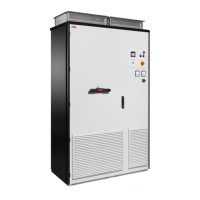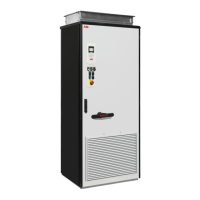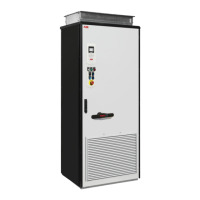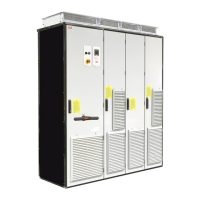The Safe torque off function 207
WARNING! The Safe torque off function does not disconnect the voltage of the
main and auxiliary circuits from the drive. Therefore maintenance work on
electrical parts of the drive or the motor can only be carried out after isolating the
drive from the main supply.
WARNING! The Safe torque off functionality is only achieved through the XSTO
connector of the motor-side converter control unit. True Safe torque off
functionality is not achieved through the XSTO connectors of the line-side
converter control unit.
The Safe torque off function is supported by any ACS880 motor-side converter firmware. It
is not supported by line-side converter firmware.
WARNING! (With permanent magnet or synchronous reluctance [SynRM] motors
only) In case of a multiple IGBT power semiconductor failure, the drive system
can produce an alignment torque which maximally rotates the motor shaft by
180/p (with permanent magnet motors) or 180/2p (with synchronous reluctance [SynRM]
motors) degrees regardless of the activation of the Safe torque off function. p denotes the
number of pole pairs.
Notes:
• If a running drive is stopped by using the Safe torque off function, the drive will cut off
the motor supply voltage and the motor will coast to a stop. If this causes danger or is
not otherwise acceptable, stop the drive and machinery using the appropriate stop
mode before activating the Safe torque off function.
• The Safe torque off function overrides all other functions of the drive.
• The Safe torque off function is ineffective against deliberate sabotage or misuse.
• The Safe torque off function has been designed to reduce the recognized hazardous
conditions. In spite of this, it is not always possible to eliminate all potential hazards.
The assembler of the machine must inform the final user about the residual risks.
Maintenance
After the operation of the circuit is validated at start-up, the STO function shall be
maintained by periodic proof testing. In high demand mode of operation, the maximum
proof test interval is 20 years. In low demand mode of operation, the maximum proof test
interval is 5 or 2 years; see section Safety data (page 208). It is assumed that all
dangerous failures of the STO circuit are detected by the proof test. To perform the proof
test, do the Acceptance test procedure (page 205).
Note: See also the Recommendation of Use CNB/M/11.050 (published by the European
co-ordination of Notified Bodies) concerning dual-channel safety-related systems with
electromechanical outputs:
• When the safety integrity requirement for the safety function is SIL 3 or PL e (cat. 3 or
4), the proof test for the function must be performed at least every month.
• When the safety integrity requirement for the safety function is SIL 2 (HFT = 1) or PL d
(cat. 3), the proof test for the function must be performed at least every 12 months.
The STO function of the drive does not contain any electromechanical components.
In addition to proof testing, it is a good practice to check the operation of the function when
other maintenance procedures are carried out on the machinery.

